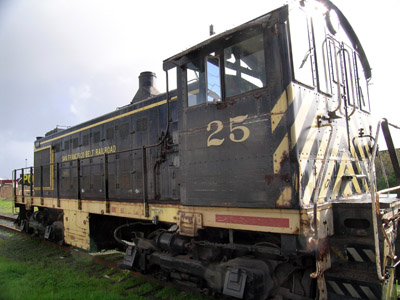The working waterfront and its cargo operations played a significant role in hosting last year’s amazing America’s Cup, but one aspect of the supply chain may have gone unnoticed: our dockside rail operations.

San Francisco has a rich history involving railroads that dates back to the late 1800’s. Photo courtesy of Port of San Francisco
By Patrick Burnson
Published: January, 2014
The working waterfront and its cargo operations played a significant role in hosting last year’s amazing America’s Cup, but one aspect of the supply chain may have gone unnoticed: our dockside rail operations.
The San Francisco Bay Railroad is a Class 3 shortline railroad that serves the City of San Francisco and the Port of San Francisco, and also operates a rail terminal in Richmond. It is independently owned and operated, and virtually all of its employees live and work in the community they serve.
The railroad hauled shipping containers for ORACLE TEAM USA late last summer, and by accounts, did a stellar job with on-time delivery. But it’s not all glamor.
The company’s core business is moving various commodities for several shippers using the Port of San Francisco and Richmond, to and from its railyard for interchange with the Union Pacific Railroad and the BNSF. San Francisco Bay Railroad has large railyards and can lay down areas for any number of specific shipping needs, handling up to 300 rail cars for storage or transload services.
San Francisco Bay Railroad also prides itself on its environmental stewardship, noting that shippers can reduce their carbon footprint by up to 90 percent by using rail. Even if a shipper does not have a "rail spur," the company can arrange for goods to be trans-loaded via motor carrier.
A Bit of History
San Francisco Bay Railroad was not the first to traverse the local tracks. Local historian Thomas Beutel notes that the State Belt Railroad of California was a shortline that served San Francisco’s waterfront until the 1980s. Its tracks extended the length of the Embarcadero from south of Market Street to Fort Mason and the Presidio.
Although locals nicknamed the line the "Toonerville Trolley" and the "Wooden Axle Line," the State Belt had an illustrious career. The first trackage of the State Belt was built by the Board of State Harbor Commissioners in 1889. At that time, the lands along waterfront were owned by the state, not San Francisco. These lands were once under water, so they were not included in the original survey of the City.
The original tracks were dual-gauged to allow transfer of narrow-gauge freight cars from the North Pacific Coast R.R. (Marin County) and the South Pacific Coast R.R. (Alameda, Santa Clara, Santa Cruz counties), as well as standard-gauge cars. These first tracks did not yet connect to the outside world—all cars were ferried in from around the San Francisco Bay. Belt tracks finally connected with Southern Pacific tracks in 1913 at a small interchange yard located at Townsend and Berry Streets.
The State Belt built a five-stall concrete-reinforced roundhouse at Sansome and the Embarcadero. (This historic structure still stands today as an office building.) This engine facility housed a modest number of oil-fired steam switchers and, later, ALCO S-2 diesels. The railroad also owned four freight cars—idler flatcars that were used to prevent the heavy engines from rolling onto the car ferries.
State Belt’s ferry slips were located near Fisherman’s Wharf. The railroad transferred cars from the Santa Fe, the Northwestern Pacific, and the Western Pacific. In the 1920s, the Santa Fe built its own car ferry operation in China Basin, and State Belt tracks were extended over Third Street and the Mission Creek drawbridge to make a connection.
Construction at the 1915 Panama-Pacific World’s Fair and traffic to Fort Mason justified the construction of a tunnel—1,500 feet long, 15 feet wide and 22 feet high—underneath the Fort Mason Military Reservation. Eventually tracks were extended across what is now the Marina District to Crissy Field to serve the Presidio. World War II generated a large amount of trans-Pacific traffic, and the State Belt contributed greatly to the movement of materials during the War. Army and Navy switchers were added to provide enough locomotive capacity. The State Belt also delivered trainloads of fresh troops to debarkation points, and picked up hospital trains and returning troops. The railroad moved 156 troop trains and 265 hospital trains in 1945 alone.
Operations slowly wound down as shipping moved across the Bay to Oakland. In 1969, with the state wanting to get out of the port business, San Francisco voters approved a bond issue to buy the Port of San Francisco.
But as recent international sporting events have demonstrated, the railroad continues to be a valuable and viable conduit for special cargoes requiring special service.

